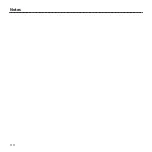
• Press the buttons lightly.
• Use the special features that are designed to minimize the times of pressing buttons,
such as Message Templates and Predictive Text.
• Take many breaks to stretch and relax.
Emergency Calls
This phone, like any wireless phone, operates using radio signals, which cannot
guarantee connection in all conditions. Therefore, you must never rely solely on any
wireless phone for emergency communications.
Loud Noise
This phone is capable of producing loud noises, which may damage your hearing.
Turn down the volume before using headphones,
Bluetooth
stereo headsets or other
audio devices.
Phone Heating
Your phone may become warm during charging and during normal use.
Electrical Safety
Accessories
Use only approved accessories. Do not connect with incompatible products or
accessories. Take care not to touch or allow metal objects, such as coins or key rings, to
contact or short-circuit in the battery terminals. Never puncture the surface of the battery
with sharp objects.
Connection to a Car
Seek professional advice when connecting a phone interface to the vehicle electrical
system.
Faulty and Damaged Products
Do not attempt to disassemble the phone or its accessories. Only qualified personnel can
service or repair the phone or its accessories. If your phone (or its accessories) has been
submerged in water, punctured, or subjected to a severe fall, do not use it until you have
taken it to be checked at an authorized service center.
CTIA Requirements
• Do not disassemble or crush, bend or deform, puncture, or shred.
• Do not modify or remanufacture, attempt to insert foreign objects into the battery,
immerse or expose to water or other liquids, expose to fire, explosion or other hazard.
• Only use the battery for the system for which it is specified.
• Only use the battery with a charging system that has been qualified with the system
per CTIA Certification Requirements for Battery System Compliance to IEEE 1725. Use
of an unqualified battery or charger may present a risk of fire, explosion, leakage, or
other hazard.
• Do not short-circuit a battery or allow metallic conductive objects to contact
battery terminals.
• Replace the battery only with another battery that has been qualified with the system
per this standard, IEEE-Std-1725. Use of an unqualified battery may present a risk of fire,
explosion, leakage or other hazard.
• Promptly dispose of used batteries in accordance with local regulations.
• Battery usage by children should be supervised.
• Avoid dropping the phone or battery. If the phone or battery is dropped, especially on
a hard surface, and the user suspects damage, take it to a service center for inspection.
• Improper battery use may result in a fire, explosion, or other hazard.
• The phone shall only be connected to CTIA certified adapters, products that bear the
USB-IF logo or products that have completed the USB-IF compliance program.
For Your Safety
For Your Safety
108
109




































